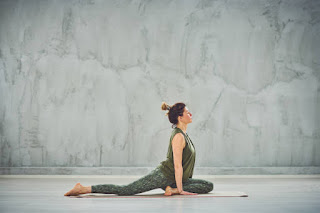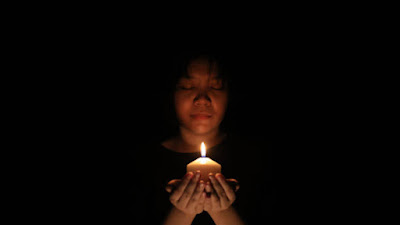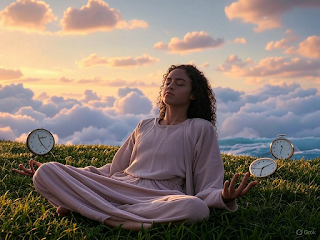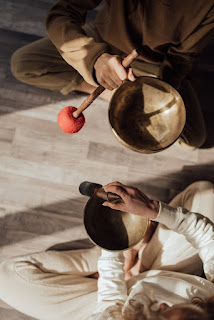The Concept of Time in Yogic Philosophy
Exploring How the Perception of Time Shifts Through Deep Stretch Yoga, Deep Meditation, and Yogic States of Consciousness
Our Relationship with Time
Time governs nearly every aspect of modern life. From the moment we wake up, we are bound by schedules, routines, and obligations—measuring our days in minutes and hours, tracking productivity, and constantly anticipating the next task. Many individuals experience time perception as rigid and unforgiving, feeling as though there is never enough time to truly be present.
Yet, there are moments when time seems to behave differently. A joyful experience may feel fleeting, while discomfort stretches endlessly. In deep states of yoga practice or meditation, time can appear to slow down or even dissolve completely. This shift in temporal perception is more than just an illusion; it reflects a fundamental truth about how the mind processes time and how yoga breathing techniques, meditation, and mindfulness can transform our experience of it.
In yoga philosophy, time is not merely a linear sequence of past, present, and future. Instead, it is a dynamic and fluid experience. We can consciously shape through breath, awareness, and movement. Yogis throughout history have explored ways to expand, slow, or transcend time altogether, achieving states of pure consciousness where time ceases to exist as we know it.
This article will explore the relationship between yoga practice and time perception, drawing from both ancient wisdom and modern cognitive science. Additionally, we will highlight the availability of quick and easy yoga classes for beginners, making it convenient for anyone to start or enhance their yoga journey.
Time in Yogic Philosophy: The Duality of Time and Timelessness
Kala vs. Akala: The Yogic View of Time
In classical yoga philosophy, time is understood as both a measurable force and an illusion. While the modern world operates within strict time structures work schedules anddeadlines. Ancient yogic teachings recognize two fundamental aspects of time:
Kala (Chronological Time): This is the conventional understanding of time linear, measurable, and structured. It governs daily life, where events follow a clear sequence, such as waking up, attending yoga classes, or tracking elapsed time during a meditation session.
Akala (Timelessness): This is the state of transcending time, where past and future dissolve into an eternal present moment. In deep meditation and higher states of consciousness, time loses its rigid structure, and awareness expands beyond shorter intervals and mental constraints.
While Kala is essential for organizing life and maintaining structure, Akala is the doorway to pure consciousness—a state where the mind moves beyond attachments to past regrets or future anxieties.
The Illusion of Time in Deep Meditation
Many yogis and meditators describe moments where time feels stretched, suspended, or even nonexistent. This phenomenon is not just anecdotal; research in cognitive science and integrative neuroscience suggests that meditation alters temporal perception by shifting how the brain processes successive events and visual stimuli.
One key effect observed in meditation is the “oddball effect,” a phenomenon where an unexpected stimulus such as a deep, slow breath or the repetition of a mantra creates a distortion in time perception. This is why a 20-minute meditation session can sometimes feel like hours, or why deep states of absorption make time seem to vanish completely.
Similarly, the opposite effect can occur where a distracted mind perceives time as moving faster, leading to the feeling that “time is slipping away.” This explains why modern life, with its constant stimulation, selling yoga apps, social media, and stock market updates, often leaves people feeling like they never have enough time.
In yogic practices, shifting from Kala to Akala requires a conscious shift in awareness. Through yoga breathing techniques, mindfulness, and deep meditation, practitioners can slow their biological stopwatch, disengage from external time pressures, and experience the present moment in its fullest depth.
The Illusion of Time in Deep Meditation
Time is not as rigid as it seems. While clocks measure time in fixed increments, our temporal perception is highly fluid shaped by attention, awareness, and emotional states. In deep meditation and yoga practice, time can slow down, speed up, or dissolve entirely, revealing the illusory nature of chronological time (Kala) and opening the door to a more expansive experience of reality.
How Meditation Alters Time Perception
Scientific research in cognitive science and integrative neuroscience suggests that meditation changes the way we process successive events and track elapsed time. Several mechanisms contribute to this effect:
Changes in Brain Wave Activity
- In ordinary waking consciousness, the brain operates primarily in beta waves, associated with logical thinking, planning, and analyzing.
- During meditation, brain activity shifts toward alpha and theta waves, which promote relaxation, introspection, and timeless awareness.
- In deep meditative absorption (Jhanas or Samadhi), the brain exhibits gamma wave synchronization, linked to pure consciousness, where time may completely dissolve.
The “Oddball Effect” and Temporal Distortions
- The oddball effect refers to how the brain perceives unexpected stimuli as lasting longer than predictable events.
- In meditation, focusing on a mantra, the breath, or yoga breathing techniques creates an “oddball” experience slowing perceived time as the mind enters deep focus.
- This explains why meditators often feel as though their practice extends far beyond the clock’s measure.
- The DMN, responsible for mind-wandering, self-referential thinking, and constructing past and future narratives, is significantly reduced during meditation.
- With the DMN quieted, thoughts about past regrets or future worries fade, leaving the meditator in a state of present-moment awareness where time perception is radically altered.
The Experience of Timelessness in Yogic States
Different levels of meditation practice lead to distinct temporal illusions, ranging from subtle distortions to complete transcendence of time:
Early Meditation Practice (Beginners)
- Time slows down slightly as awareness shifts inward.
- Thoughts of past and future diminish, but time is still noticeable.
- Stronger feelings of expansion as if the present moment holds infinite depth.
- A 20-minute meditation may feel like it lasts much longer.
- Complete dissolution of time past, present, and future merge into an eternal now.
- Practitioners report a sense of infinity or a feeling of merging with a greater consciousness.
- In extreme cases, long meditation sessions feel like only moments have passed upon returning to normal awareness.
This experience is well-documented in yogic texts and personal accounts from practitioners across different traditions. Many describe Samadhi as the moment when the self, time, and external reality disappear into a unified field of pure awareness.
How This Applies to Daily Life
Understanding these shifts in time perception can have profound effects on daily life. With consistent yoga practice and meditation:
- Stress about time diminishes, reducing anxiety over deadlines and schedules.
- The ability to stay present in each moment increases, leading to greater fulfillment.
- A natural sense of flow develops where time is no longer an enemy, but an ally.
By practicing yoga breathing techniques, focused attention, and deep meditation, anyone can begin to experience time as a fluid, expansive reality rather than a rigid structure.
Time as a Relative Concept
Time is a relative concept that can be perceived differently by individuals depending on their experiences, emotions, and focus. In the context of yoga, time can be seen as a tool for self-realization and personal growth. By cultivating mindfulness and awareness, yoga practitioners can transcend the constraints of time and space, achieving a deeper understanding of themselves and the world around them.
In yoga practice, the perception of time can shift dramatically. For instance, during a deep stretch yoga session, time may seem to slow down as you sink into each pose, allowing you to fully experience the present moment. Conversely, in more dynamic strength yoga classes or cardio yoga sessions, time might appear to speed up due to the heightened energy and continuous movement. This fluidity in time perception underscores the idea that time is not a fixed entity but a malleable experience shaped by our state of mind and level of awareness.
By engaging in regular yoga practice, whether through popular yoga classes or using a free yoga app designed for various levels, individuals can learn to navigate the ebb and flow of time with greater ease. This heightened awareness can lead to a more balanced and fulfilling life, where time is no longer a source of stress but a medium for growth and self-discovery.
Time as a Tool for Self-Realization
In yoga philosophy, time is not just a measure of moments passing but a profound tool for self-realization and liberation. Through consistent yoga practice, individuals can develop a deeper awareness of their thoughts, emotions, and actions, enabling them to make conscious choices that align with their true selves.
Yoga classes, ranging from beginner yoga categories to more advanced levels, offer structured environments where practitioners can explore their inner landscapes. By focusing on the present moment during these sessions, individuals can cultivate a sense of inner peace and calm. This mindfulness extends beyond the mat, helping them navigate life’s challenges with greater clarity and resilience.
For intermediate yoga students, the journey towards self-realization often involves delving deeper into meditation classes and advanced yoga breathing techniques. These practices help quiet the mind, allowing practitioners to connect with their inner wisdom and intuition. Over time, this connection fosters a sense of purpose and direction, guiding individuals towards a more authentic and fulfilling life.
In essence, yoga transforms time from a linear progression into a cyclical journey of self-discovery. Each breath, each pose, and each moment of stillness becomes an opportunity to deepen one’s understanding of the self and the universe. This timeless wisdom, passed down through generations of yogis, continues to inspire and empower modern practitioners on their path to self-realization.
Yogic Practices and Yoga Breathing Techniques That Shift Time Perception
As we have explored, yoga practice and meditation have the power to alter our perception of time, allowing us to experience the present moment more fully. Incorporating the most popular yoga classes into your routine can provide foundational options that cater to various yoga needs, making it easier for both beginners and experienced practitioners to cultivate this shift in everyday practice.
Additionally, top selling yoga apps are known for their credibility and quality, offering valuable resources for yoga enthusiasts. These apps, such as Yoga Time, often feature classes from leading applications like The Yoga Collective, ensuring a high standard of practice.
Several key yoga breathing techniques, meditation styles, and movement-based practices help slow down the mind’s perception of elapsed time, creating a sense of spaciousness and stillness. These practices work by regulating the breath, refining concentration, and deepening self-awareness—ultimately leading to states of pure consciousness where time loses its rigidity.
Breath as a Time Regulator: Pranayama
One of the most accessible ways to alter temporal perception is through yoga breathing techniques, known as pranayama. Since breath and time are deeply intertwined—our nervous system uses breath as a natural metronome slowing or extending the breath has a direct impact on how we experience time.
- Slow Breathing & Time Expansion
- Practicing slow, deliberate breathing activates the parasympathetic nervous system, calming the mind and reducing the sense of urgency.
- This technique is often used in restorative yoga and yin yoga to encourage deep relaxation.
- Example: Viloma Pranayama (Interrupted Inhalation) breaks the breath into stages, naturally slowing down the perception of time.
- Extended Exhalations & Timelessness
- Lengthening the exhalation signals the brain to slow one’s ability to process external stimuli, creating a feeling of stillness.
- Example: Ratio Breathing (1:2) – Inhaling for 4 counts, exhaling for 8.
- Kumbhaka (Breath Retention) & The Suspension of Time
- Holding the breath between inhales and exhales can create a sensation of time suspension, as experienced in advanced detox yoga or balance yoga practices.
By integrating these yoga breathing techniques into a daily practice, practitioners develop greater control over perceived time, allowing them to slow time down at will and remain present even in fast-paced situations.
Dharana & Dhyana: Concentration and Meditation as Time Shapers
Meditation plays an essential role in reshaping time by shifting awareness away from successive events and into a more fluid, expansive state of consciousness. Two key yogic concepts help with this transformation:
- Dharana (Concentration): Focusing on a single object—such as the breath, a mantra, or a candle flame reduces the mind’s tendency to jump between past and future thoughts. This anchors awareness in the present moment, naturally slowing the biological stopwatch that governs time perception.
- Dhyana (Meditation): As concentration deepens, meditation transcends the concept of time altogether, leading to experiences of pure consciousness where shorter intervals tend to stretch, creating a timeless sensation.
Meditation Techniques for Time Expansion
- Trataka (Candle Gazing): Fixing the gaze on a candle flame stills the mind, reducing external time cues and fostering deep presence.
- Mantra Meditation: Repeating a phrase like “So Hum” (I am that) or “Om” extends the sense of time by drawing attention inward.
- Yoga Nidra (Yogic Sleep): A guided relaxation that moves practitioners between wakefulness and deep rest, altering time perception as they drift between conscious and subconscious states.
Movement & Time Perception: The Role of Asana
While meditation and breathwork create deep states of stillness, yoga asana (postures) can also shift one’s perception of time particularly in deep stretch yoga, heart-opening yoga classes, and restorative yoga practices.
- Slow, Controlled Movements (Time Dilation)
- Gentle, mindful yin yoga poses, held for several minutes, allow time to feel stretched and fluid.
- Example: Supta Baddha Konasana (Reclining Bound Angle Pose) – Often used in beginner yoga series to cultivate deep relaxation.
- Rhythmic Flow (Time Acceleration)
- In contrast, faster-paced strength yoga classes or cardio yoga can make time feel like it’s passing more quickly due to heightened energy and increased sensory input.
- Example: Surya Namaskar (Sun Salutations) Often featured in popular yoga classes, helping practitioners feel energized yet timeless.
The key is intentionality—whether slowing movements down to stretch time or increasing movement to enter a flow state where time disappears completely.
Sensory Withdrawal: Pratyahara and Temporal Illusions
Another powerful yogic technique for altering time is pratyahara, the withdrawal of sensory input. By reducing visual stimuli and external distractions, the mind enters a state of internal awareness, where the usual markers of time light, sound, movement are diminished.
This can be experienced through:
- Dark Room Meditation: Closing the eyes or meditating in a dimly lit space removes visual stimuli, leading to altered time perception.
- Floating or Sensory Deprivation Tanks: These environments reduce the brain’s ability to track elapsed time, creating a profound sense of timelessness.
- Silent Retreats & Extended Meditation Sessions: By stepping away from external time constraints, many intermediate yoga students and advanced practitioners experience psychological science-backed changes in their perception of time.
Bringing These Practices Into Daily Life
By incorporating yoga breathing techniques, meditation, and intentional movement, it is possible to reshape our relationship with time—not just during practice, but throughout daily life.
- Morning: Start the day with a few rounds of deep stretch yoga and slow breathing to set a spacious tone for the day.
- Afternoon: Take mindful breaks, even just for a minute, to practice breath awareness and reset your perception of time.
- Evening: Use restorative yoga or yin yoga to slow down before sleep, helping to shift into a timeless awareness.
Through conscious practice, time can transform from a rigid constraint into a fluid and expansive experience, bringing greater peace and presence into all aspects of life.
Yoga Breathing Techniques to Manage Time
Yoga breathing techniques, or pranayama, are powerful tools for managing time perception and enhancing overall well-being. By consciously regulating the breath, practitioners can calm the mind, reduce stress, and create a sense of spaciousness in their daily lives. Here are some popular yoga breathing techniques that can help manage time:
Yoga Sequence for Intermediate Yoga Students: Moving Beyond Linear Time
This yoga sequence is designed to help shift your perception of time by slowing down movement, deepening awareness, and enhancing the mind-body connection. The practice integrates yoga breathing techniques, sustained holds, and fluid transitions to encourage a spacious sense of presence, moving away from the rigid constraints of chronological time (Kala) and into a state of timeless awareness (Akala).
Practice Guidelines:
- This sequence is suitable for beginner yoga series, intermediate yoga students, and experienced practitioners looking to cultivate deep stretch yoga and mindful awareness.
- Hold each pose for at least 5-10 breaths to allow time to slow down and deepen the mind’s connection to the present.
- Focus on yoga breathing techniques, emphasizing slow inhalations and extended exhalations to regulate time perception and still the mind.
Mountain Pose with Breath Awareness
- Stand tall with feet hip-width apart, grounding firmly into the earth.
- Close your eyes and bring awareness to your breath and body temperature as you inhale and exhale.
- With each inhale, feel time expanding. With each exhale, allow tension to dissolve.
Modification: Place hands in Anjali Mudra (prayer position) at the heart center to enhance self-awareness and inner stillness.
Standing Forward fold
- From Tadasana, exhale and fold forward at the hips, allowing your head to hang heavy.
- Let go of external distractions and the sensation of time passing.
- Imagine stress and mental urgency melting into the ground.
Deepen the Pose: Hold opposite elbows and gently sway side to side, tuning into the fluidity of movement rather than structured time.
Vrikshasana (Tree Pose)
- Shift weight onto your left foot, placing the right foot on the inner left calf or thigh (avoid the knee).
- Press palms together at the heart and soften your gaze to minimize visual stimuli, reducing distractions that anchor you in elapsed time.
- Feel your breath steadying, creating a sensation of time slowing down.
Advanced Variation: Close your eyes briefly and notice how removing external reference points affects your sense of balance and time perception.
Eka Pada Rajakapotasana (Pigeon Pose)
- From Downward Dog, bring your right knee forward, placing it behind your right wrist. Extend the left leg back.
- Fold forward over your leg and rest your forehead on stacked fists or the mat.
- Breathe deeply, allowing time to stretch and dissolve.
Mental Focus: Imagine sinking into pure consciousness, where shorter intervals tend to disappear, and only this moment remains.
Viparita Karani (Legs Up the Wall Pose)
- Sit sideways next to a wall, then swing your legs up and lie back.
- Rest arms by your sides with palms facing up, closing your eyes.
- Inhale for a count of 4, exhale for a count of 8—using breath to extend the perception of time and enter a meditative state.
Visualization: Picture a timeless space, free from past or future concerns, allowing yourself to simply be.
Savasana (Corpse Pose) – Dissolving Time Completely
- Lie on your back, arms relaxed at your sides.
- Focus on subtle sensations—breath, heartbeat, and the feeling of time passing without measuring it.
- Let go of all effort and enter a state of pure awareness, as if floating in an infinite now.
Optional Add-On: Use a guided meditation or soft music to deepen relaxation and enhance temporal illusions, where minutes feel like hours or vice versa.
Closing the Practice: Returning to Time with Awareness
- Gently bring movement back, wiggling fingers and toes.
- Roll to one side, pausing in fetal position before rising.
- Sit in a comfortable position, bringing hands to heart center.
- Acknowledge the shift in your perception of time—has it slowed, expanded, or changed in any way?
With this premium yoga experience, you’ve consciously altered your psychological sense of time, moving beyond structured moments into a deeper connection with presence.
Meditation Classes Prompt: Entering the Eternal Now
Meditation is one of the most powerful tools for altering time perception and stepping beyond the mental constraints of past and future. In deep meditative states, the mind slows, thoughts dissolve, and the awareness of time as a series of successive events fades.
This guided meditation is designed to help you experience Akala (timelessness) a state where elapsed time, external distractions, and the rush of daily life disappear, leaving only the pure presence of now.
Guided Meditation: Expanding Awareness Beyond Time
Preparation:
- Find a quiet, comfortable space where you won’t be disturbed.
- Sit in a cross-legged position or lie down in Savasana.
- Close your eyes and take a deep breath, letting go of any urgency or expectation.
- Begin with a simple body scan, softening tension in your jaw, shoulders, and abdomen.
Slowing the Internal Clock with Breath
- Inhale deeply through the nose for a count of 4.
- Hold the breath for a count of 2.
- Exhale slowly through the mouth for a count of 8.
- Repeat this cycle for several minutes, allowing the breath to regulate your biological stopwatch and slow your sense of time.
Notice: Does time feel different when you focus on breathing rather than external events?
Visualizing Time as a Flow
- Picture yourself standing beside a river, watching the water move.
- Each ripple represents a moment rising, passing, dissolving.
- Watch how the river flows effortlessly neither rushing forward nor lingering in the past.
Reflection: Just as the river moves without force, so does time. There is no need to grasp it or chase it.
Dissolving Time into the Present Moment
- Now, shift your awareness inward what if there is no river, no movement?
- Instead of seeing time as something passing, simply exist.
- Notice the stillness between one breath and the next a space where time ceases to exist.
- Rest in this timeless awareness, beyond any measure of shorter intervals or successive thoughts.
Mantra Suggestion: Mentally repeat “I am here. I am now.” with each inhale and exhale.
Returning with a Shifted Perspective
- Slowly bring awareness back to your breath and body.
- Wiggle your fingers and toes, feeling grounded but spacious.
- Open your eyes gently, taking a moment to observe your surroundings do they feel different?
- Move slowly as you transition out of stillness, noticing whether your perception of time has changed.
As you continue your yoga practice, try integrating this meditation into your daily yoga needs, whether after popular yoga classes, as part of a beginner yoga series, or simply during a mindful pause in your day.
Reflective Journaling: Exploring Your Perception of Time
After practicing the yoga sequence and meditation, your perception of time may feel different more spacious, fluid, or even timeless. Journaling immediately after these practices can help solidify insights, deepen self-awareness, and allow you to track changes in your relationship with time over days, weeks, or months.
Below is a set of journaling prompts designed to help you reflect on how yoga practice, breathing techniques, and meditation have influenced your temporal perception and overall presence.
Journaling Prompts: Observing the Shifts in Time Perception
- How did time feel during your practice?
- Did time feel slower, faster, or completely unmeasured?
- Were there moments where time seemed to dissolve or expand?
- Compare this experience to daily life.
- How does your perception of time during yoga or meditation differ from when you are engaged in daily tasks?
- Do you feel rushed, pressured, or stretched for time in your normal routine? How does this contrast with how time felt in today’s practice?
- What emotions arise when you consider the concept of timelessness?
- Does the idea of stepping outside of linear time bring you comfort, excitement, or unease?
- How do you feel when you let go of measuring elapsed time?
- How do external influences shape your sense of time?
- How does engaging with digital distractions like stock market updates, news feeds, or social media affect your experience of time?
- Do you notice a difference between time spent in pure awareness versus time spent multitasking or consuming external stimuli?
- How can you bring more spaciousness into your daily life?
- What small moments in your routine could benefit from deeper presence?
- How can you integrate yoga breathing techniques, restorative yoga, or meditation classes to cultivate a more balanced perception of time?
A Mindful Exercise: Measuring Time Without a Clock
To further explore the fluidity of time, try this simple exercise:
- Find a quiet place where you won’t be disturbed.
- Set a timer for 5-10 minutes but don’t look at it.
- Close your eyes and simply observe your breath, body, and thoughts.
- When you feel like 5 or 10 minutes have passed, open your eyes and check the timer.
- Reflect: Did time feel shorter or longer than expected? What influenced your perception?
Through yoga practice, meditation, and breath awareness, we can reshape our experience of time, moving beyond stress-driven urgency into a more intentional and spacious way of being. By tuning into the present moment, we learn that time is not something to be controlled or chased it is something to be experienced fully.
The more we practice, the more we cultivate an intuitive relationship with time one that allows us to flow effortlessly between structure and stillness, routine and presence, past and future, all while remaining anchored in the eternal now.
Embracing a Timeless Perspective
Time is one of the most fundamental aspects of human experience, yet yoga practice and meditation reveal that it is far more fluid than we often perceive. In our day-to-day lives, time can feel like a constraint something to manage, race against, or struggle to find enough of. But as we have explored, through yoga breathing techniques, movement, and meditative awareness, we can shift this perception, allowing time to feel more spacious, intuitive, and even transcendent.
By integrating these practices into your daily routine whether through mindful breathing, slow and intentional movement, or moments of deep stillness you can cultivate a more expansive relationship with time. Rather than feeling rushed or constrained by schedules, you may begin to notice that time is not something to control, but something to surrender into.
As you continue your yoga journey, consider how you can bring more presence and timelessness into different aspects of life:
- Can you slow down and fully experience each breath?
- Can you allow time to pass without counting minutes and hours?
- Can you carry the spaciousness you cultivate in practice into your everyday interactions and routines?
Through conscious practice, we move beyond the illusion of time and into the richness of the present moment. This is the gift of yoga not just greater flexibility or strength, but a profound shift in awareness that allows us to live with greater ease, peace, and connection.
Take this wisdom beyond your mat. Allow yourself to experience life fully, without rushing, without measuring just being.
“Eternity is not something that begins after you are dead. It is going on all the time.”
—Charlotte Perkins Gilman











